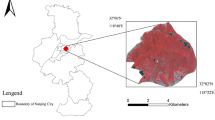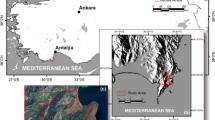Abstract
Change detection is used to detect changes after the Bhuj earthquake of January 26, 2001 and quantify the intensity of changes using remote sensing and GIS techniques. Changes are generally studied for their locations and spatial distribution, band sensitivity, aerial extent (quantity of changes), nature (permanent change, seasonal/cyclic change) and processes are inferred that may have led to the changes. The present research is an attempt to quantify the intensity of changes using remote sensing and GIS techniques. It may be possible to just visually detect changes in landscape, but to detect the variations in intensity of changes, techniques of image processing need to be employed. In the present study, one of the techniques of change detection, namely ‘temporal band differencing,’ is used to detect changes in landscape and their intensity after the Bhuj earthquake (26th January 2001, magnitude = 7.9 on Richter scale). In this method of change detection, temporal difference between two images is computed by subtracting time 2 image values from time 1 image values (brightness values) of corresponding pixels. Output image contains absolute differences in brightness values of corresponding pixels. This research work attempts to study the change detection technique in which bandwise change detection and areawise change detection is carried out. All the changes are then correlated with the geology and tectonics of the area around Bhuj and epicenter of the Bhuj earthquake.










Similar content being viewed by others
References
Alberga V (2009) Similarity measures of remotely sensed multi-sensor images for change detection applications. Remote Sens I. doi:10.3390/rs1030122
Chavez PS Jr (1989) Radiometric calibration of landsat thematic mapper multispectral images. Photogramm Eng Remote Sens 55:1285–1294
Dasgupta S, Pande P, Venkatraman NV, Narula PL, Dasgupta S, Iqbal Z, Banerjee J, Ganguly D, Sanyal K, Acharyya SK (eds) (2000) Seismotectonic atlas of India and its environs. Geological Survey of India
Earthquake Engineering Research Institute (EERI) (2002) Bhuj, India earthquake of January 26, 2001. Reconnaissance Report Earthquake Spectra, vol 18, no. S1, pp 1–398
Ekstrand S (1994) Assessment of forest damage with Landsat TM: correction for varying forest stand characteristics. Remote Sens Environ 47:291–302
Huguenin RL, Karaska MA, Blaricom DV, Jensen JR (1997) Subpixel classification of bald cypress and tupelo gum tress in thematic mapper imagery. Photogramm Eng Remote Sens 63(6):717–725
Jain SK, Murty CVR, Dayal U, Arlekar JN, Chaubey SK (2001) The republic day earthquake in the land of M. K. Gandhi, the father of the Nation. NICEE, EERI, IIT, Kanpur, Oakland
Jakubauskas ME (1996) Thematic mapper characterization of Lodgepole pine seral stages in Yellowstone National Park, USA. Remote Sens Environ 56:118–132
Lillesand TM, Kiefer RW (1987) Remote sensing and image interpretation. Wiley, New York
McGee CA (2005) Detection of Bhuj earthquake liquefaction. http://academic.emporia.edu/aberjame/student/mcgee1/finlproj.htm
Murty CVR, Greene M, Jain SK, Prasad NP, Mehta V (2005) Earthquake rebuilding in Gujarat, India, an EERI recovery reconnaissance report. Earthquake Engineering Research Institute, Oakland
Seismo-watch (2001) Special Earthquake Report No: 01-002. https://www.eeri.org/2001/01/bhuj/
Shaoqing Z, Lu X (2008) The comparative study of three methods of remote sensing image change detection. The Internl. Archv. Of the Photogramm., Remote Sensing and Spatial Informn.Scis., Vol. XXXVII, part B7, Beijing
Singh RP, Bhoi S, Sahoo AK, Kanwar R (2001) Changes in Ocean. GIS @ Dev 5:35–36
Singh RP, Bhoi S, Sahoo AK (2002) Changes observed on land and ocean after Gujarat earthquake of January 26, 2001 using IRS data. Intern J Remote Sens 23(16):3123–3128
Song C, Woodcock CE, Seto KC, Lenney MP, Macomber SA (2001) Classification and change detection using landsat TM data: when and how to correct atmospheric effects? Remote Sens Environ 75:230–244
Spanner MA, Pierce LL, Peterson DL, Running SW (1990) Remote sensing of temperate coniferous forest leaf area index: the influence of canopy closure, understory vegetation and background reflectance. Int J Remote Sens 11(1):95–111
Acknowledgments
The authors acknowledge here the help and the support extended by the Department of Geography, University of Pune, Pune. The satellite images used for the research are purchased for the funds allotted under Respond programme of the Indian Space Research Organization (ISRO) to the University of Pune. We are thankful to the ISRO for making funds available for research. The corresponding author was working as an assistant professor in the Department of Geography, University of Pune, and recently has joined the Department of Geography, University of Mumbai, Mumbai. Both the authors are thankful to the respective departments of both the Universities.
Author information
Authors and Affiliations
Corresponding author
Rights and permissions
About this article
Cite this article
Joshi, K., Gadkari, D. Quantification of intensity of landscape changes using remote sensing and GIS with special reference to the Bhuj earthquake (26th January, 2001, M = 7.9). Nat Hazards 83, 989–1005 (2016). https://doi.org/10.1007/s11069-016-2359-0
Received:
Accepted:
Published:
Issue Date:
DOI: https://doi.org/10.1007/s11069-016-2359-0




